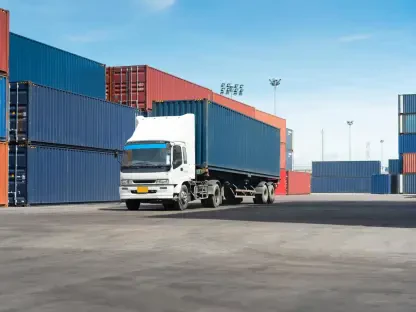Recent disruptions in international trade policies have highlighted the necessity for comprehensive visibility across supply chains, as companies face the dual challenge of maintaining operational stability and adhering to regulatory compliance. The introduction of new tariffs by President Donald Trump last week, including a 10 percent tariff on Chinese imports and the initial imposition of 25 percent tariffs on Canadian and Mexican goods that were subsequently suspended, illustrates the unpredictable nature of modern trade policies. With these frequent policy shifts, companies lacking transparency into their lower-tier suppliers are at significant risk. This unpredictability can lead to sudden price increases, compliance issues, and production delays, which could jeopardize a firm’s market position and profitability.
The Risks of Poor Supply Chain Visibility
In an increasingly complex global market, data quality and comprehensiveness are fundamental to navigating supply chain challenges. According to Alex Bowles from Transparency-One, businesses with intricate global supply chains face numerous difficulties stemming from inadequate or incomplete data. These challenges are compounded by the unpredictability of trade policies, which can rapidly change without forewarning. If companies are unaware of their lower-tier suppliers’ circumstances, they may be caught off-guard by new regulatory requirements or sudden shifts in the market, leading to inefficiencies and increased costs.
Poor supply chain visibility also undermines a company’s ability to comply with stringent environmental and human rights regulations. Non-compliance can result in severe financial penalties and, in some cases, the withdrawal of products from the market. Furthermore, sustainability concerns such as water stress, extreme weather, and regional conflicts can disrupt production processes, negatively impacting a company’s bottom line. Therefore, understanding these factors is crucial for implementing effective mitigation strategies and reassessing sourcing methods to ensure continuous operations and sustained profitability.
Ensuring Compliance and Sustainability
In addition to guarding against tariff-related disruptions, visibility in supply chain operations is essential for ensuring compliance with an ever-growing list of regulations. Companies need to maintain rigorous documentation and tracking systems to demonstrate their adherence to environmental and human rights standards. This transparency is vital not only for avoiding legal repercussions but also for maintaining consumer trust and brand reputation. As consumers become more educated and concerned about the origin and impact of their purchases, companies are under increasing scrutiny to demonstrate their commitment to ethical practices.
Moreover, understanding the environmental factors that can affect different regions allows companies to proactively address potential disruptions in their supply chain. For instance, having visibility into water stress levels in a supplier’s region enables companies to plan for alternative sourcing strategies or to invest in technologies that reduce water usage. By doing so, companies can mitigate the impact of extreme weather conditions and regional conflicts on their supply chains. These measures not only protect the business from immediate disruptions but also enhance long-term resilience and sustainability.
Enhancing Stakeholder Engagement
Visibility and transparency in supply chain operations play a pivotal role in enhancing stakeholder engagement. When companies clearly understand and communicate their supply chain practices, they build trust with customers, investors, and other stakeholders. Lack of knowledge and transparency can severely damage credibility, reduce sales, and deter investment. In today’s market, transparency is not just a regulatory requirement; it is a competitive advantage. Companies that can demonstrate a clear and ethical supply chain strategy are better positioned to win over conscientious consumers and investors who prioritize sustainability.
Therefore, engaging with suppliers and leveraging technology for supply chain mapping and data centralization is crucial. Real-time tracking and monitoring help identify risks promptly and implement effective mitigation strategies, thereby protecting revenue. Furthermore, nurturing relationships with suppliers committed to sustainable practices ensures alignment with the company’s values and operational goals. This holistic approach to supply chain management not only minimizes risks but also fosters long-term resilience and success.
Prioritizing Technology and Supplier Engagement
To address the challenges posed by volatile trade policies and the need for compliance, companies must prioritize technology and supplier engagement. Centralizing supplier information through advanced supply chain mapping technologies allows for real-time tracking and monitoring, which helps identify and address risks more efficiently. Technologies such as blockchain can further enhance transparency by providing a decentralized and immutable record of all transactions, helping to ensure data accuracy and integrity across the entire supply chain. This centralization facilitates rapid responses to disruptions, ensuring that companies can adapt to new regulations or market conditions quickly.
Effective supplier engagement involves selecting and nurturing relationships with suppliers who share the company’s commitment to sustainable practices. Regular communication, thorough vetting processes, and collaboration are essential for building strong partnerships and ensuring that suppliers adhere to the required standards. By fostering a collaborative environment, companies can work with suppliers to develop innovative solutions that address both compliance and sustainability challenges. This proactive approach not only mitigates risks but also enhances the overall efficiency and resilience of the supply chain, ensuring long-term success in a dynamically changing global trade environment.
Navigating the Future Trade Environment
In today’s complex global market, high-quality and comprehensive data are critical for effectively managing supply chain challenges. Alex Bowles from Transparency-One emphasizes that businesses with intricate global supply chains encounter numerous difficulties due to inadequate or incomplete data. These problems are exacerbated by the unpredictable nature of trade policies, which can change abruptly without prior notice. If companies are unaware of the conditions affecting their lower-tier suppliers, they risk being blindsided by new regulations or sudden market shifts, resulting in increased inefficiencies and costs.
Poor visibility in supply chains hampers a company’s ability to comply with strict environmental and human rights regulations. Non-compliance can lead to hefty financial penalties and potential product withdrawals. Additionally, sustainability issues such as water stress, extreme weather, and regional conflicts can disrupt production, negatively impacting profitability. Hence, understanding these factors is essential for devising effective mitigation strategies and reassessing sourcing methods to ensure ongoing operations and profitability.









